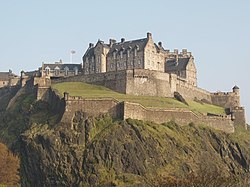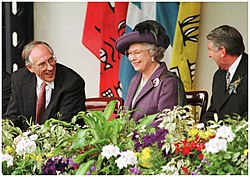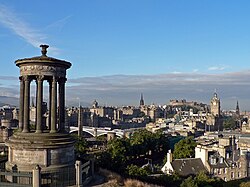Edinburgh

Edinburgh (Scottish Gaelic: Dùn Èideann) is the capital city and second largest city in Scotland. Edinburgh lies on the east coast, where the River Forth flows into the sea.
The central part is Edinburgh Castle, at the top of a steep hill. The castle has a military display every year, called a tattoo, where soldiers show their skills at marching and competitions, and there are brass bands and bands of bagpipes.
Edinburgh has a very large festival every year, where thousands of performers come to put on shows. The Edinburgh International Festival takes place in August and September. At the same time there is the Edinburgh Fringe. The shows are of all kinds, and range from large ones with famous people, to very small ones by new or unknown actors.
The city is served by Edinburgh Airport, and Haymarket and Waverley railway stations.
Old and New towns
The Old Town of Edinburgh is the oldest part of the city, and with the 18th-century New Town, it is a UNESCO World Heritage Site. It has preserved its mediaeval plan and many Reformation-era buildings. The Old and New Towns are known locally simply as "Town". It is the city centre. The main part of the Old Town is a complex of streets called the Royal Mile while Princes Street is the main business area of the New Town.
Sport
The city's main football teams are Heart of Midlothian F.C. and Hibernian F.C. Murrayfield stadium in the city is the home of the Scottish national rugby team and Edinburgh Rugby. The nearby Murrayfield Ice Rink is home to the city's ice hockey team, the Edinburgh Capitals. See also Leith Athletic F.C.
Buildings
Edinburgh has lots of important buildings. The Balmoral Hotel was opened in 1902 and designed by W. Hamilton Beattie. Saint Giles' Cathedral was built in Mediaeval times. There was a big fire there in 1385. The Royal Museum was designed by architect Francis Fowke and built between 1861 and 1888. Its sister museum, the Museum of Scotland, was designed by Benson and Forsyth in 1998.
Holyrood Palace was once the home of the Scottish kings, and is open to the public. It now serves as the King of Britain's Scottish residence. The Scottish Parliament is located next to Holyrood Palace.
Governing
Edinburgh is one of the 32 local government areas of Scotland. It has its own council which is led by the Lord Provost (similar to a mayor). The city is divided into 17 "wards" which elect their councillors.
Famous people from Edinburgh
- Sir Walter Scott, who wrote many historical stories.
- Alexander Graham Bell, who invented the telephone, was born in Edinburgh.[1]
- Sir Arthur Conan Doyle who wrote the Sherlock Holmes stories.
- Robert Louis Stevenson who wrote Kidnapped, Treasure Island, Doctor Jekyll and Mr Hyde and many other stories.
- Muriel Spark, who wrote The Prime of Miss Jean Brodie and many other stories.
- Sean Connery, who acted as James Bond in films.
Twin Towns
Edinburgh is twinned with:
Edinburgh Media
Surgeons' Hall, one of the Greek Revival buildings that earned Edinburgh the nickname "Athens of the North"
A painting showing Edinburgh characters (based on John Kay's caricatures) behind St Giles' Cathedral in the late 18th century
Queen Elizabeth II and Donald Dewar at the opening of the Scottish Parliament, 1999
Skyline of the Edinburgh Old Town
References
- ↑ "Alexander Graham Bell Laboratory Notebook, 1875-1876". World Digital Library. 1875–1876. Retrieved 2013-07-24.












